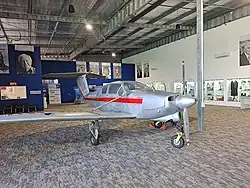| R-2 | |
|---|---|
 | |
| The prototype Victa R-2 on display at the HARS Museum | |
| Role | Light aircraft |
| National origin | Australia |
| Manufacturer | Victa Ltd. |
| Designer | Luigi Pellarini |
| First flight | 15 February 1961 |
| Status | Prototype only |
| Number built | 1 |
The Victa R-2 was a prototype Australian single-engine four-seat light aircraft built by Victa Ltd in the early 1960s. A single example was built, first flying in February 1961, but no production followed.
Design and development
In September 1959, the Australian engineering company Victa Consolidated Industries, a major manufacturer of motor lawnmowers, established an aviation department. The first intended product was the Victa R-2, a four-seat single-engine light aircraft designed by Luigi Pellarini.[1][2][3] Pellarini's design was a low-winged, all metal tractor configuration monoplane with a T-tail, powered by a 180 hp (130 kW) Lycoming O-360 flat-four piston engine driving a constant-speed propeller. The prototype's wings were braced by struts, although production aircraft may have had fully cantilever wings. The wingtips and tail were raked to reduce drag. A retractable tricycle landing gear was fitted, although the production of versions with fixed landing gear was considered for operations in the bush.[2][4]
A prototype first flew on 15 February 1961,[4] by which time Victa had received several orders for the R-2.[5] Despite these orders, no production followed. Victa had committed to production of the two-seat Airtourer (which had been ordered in much larger numbers than the R-2[5]), and chose to develop a four-seater derivative of the Airtrainer, the Aircruiser, which was expected to be cheaper to build than the R-2, instead of continuing to develop the R-2.[6] Pellarini left Victa,[6] and later went on to design the Transavia PL-12 Airtruk agricultural biplane, although attempts by Pellarini to build a development of the R-2 as the Transavia PL-13 were unsuccessful.[7][8]
Specifications (Performance estimated)
Data from Jane's All the World's Aircraft 1961–62[4]
General characteristics
- Crew: 1 pilot
- Capacity: 3 passengers
- Length: 21 ft 6 in (6.55 m)
- Wingspan: 32 ft 0 in (9.75 m)
- Height: 8 ft 3 in (2.51 m)
- Wing area: 132 sq ft (12.3 m2)
- Aspect ratio: 7.7:1
- Empty weight: 1,190 lb (540 kg)
- Gross weight: 2,250 lb (1,021 kg)
- Powerplant: 1 × Lycoming O-360-A1A air-cooled flat four, 180 hp (130 kW)
Performance
- Maximum speed: 183 mph (295 km/h, 159 kn) at sea level
- Cruise speed: 174 mph (280 km/h, 151 kn) at 5,000 ft (1,500 m) (75% power)
- Stall speed: 56 mph (90 km/h, 49 kn) (flaps down)
- Range: 740 mi (1,190 km, 640 nmi)
- Service ceiling: 16,600 ft (5,100 m)
- Rate of climb: 1,160 ft/min (5.9 m/s)
References
- ↑ Taylor 1961, p. 11
- 1 2 Brogden Flight 12 August 1960, p. 234
- ↑ Flight 27 January 1961, p. 134
- 1 2 3 Taylor 1961, p. 12
- 1 2 Flight 4 November 1960, p. 689
- 1 2 Flight 4 May 1961, p. 591
- ↑ Taylor 1966, pp. 8–9
- ↑ Taylor 1967, p. 7
- Brogden, Stanley (12 August 1960). "Australian Light Aircraft: Newcomers Enter the Club and Agricultural Markets". Flight. Vol. 78, no. 2683. pp. 234–235. Retrieved 23 November 2019.
- "Orders for Victa". Flight. Vol. 78, no. 2695. 4 November 1960. p. 689. Retrieved 23 November 2019.
- "Sport and Business". Flight. Vol. 79, no. 2707. 27 January 1961. p. 134. Retrieved 23 November 2019.
- "Sport and Business". Flight. Vol. 79, no. 2707. 4 May 1961. p. 591. Retrieved 23 November 2019.
- Taylor, John W. R. (1961). Jane's All the World's Aircraft 1961–62. London: Sampson Low, Marston & Company, Ltd.
- Taylor, John W. R. (1966). Jane's All the World's Aircraft 1966–67. London: Sampson Low, Marston & Company, Ltd.
- Taylor, John W. R. (1967). Jane's All the World's Aircraft 1967–68. London: Sampson Low, Marston & Company, Ltd.